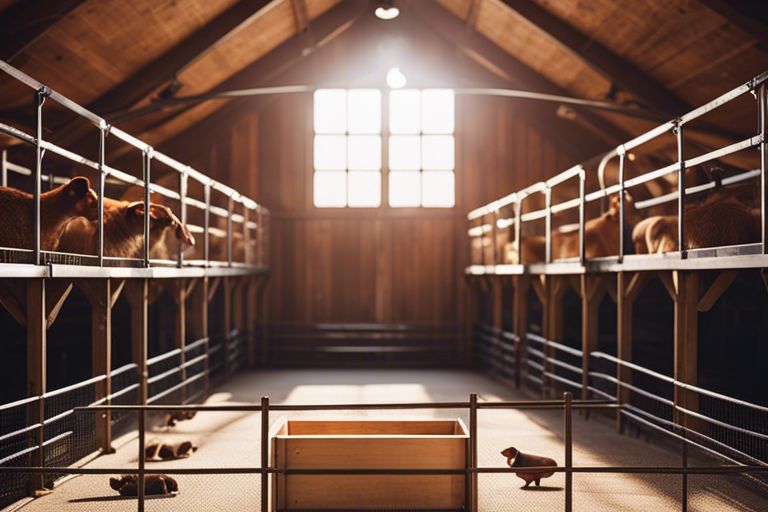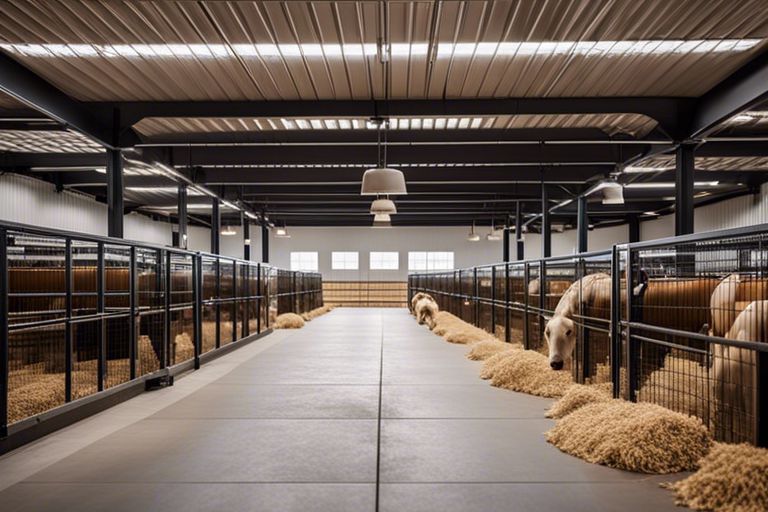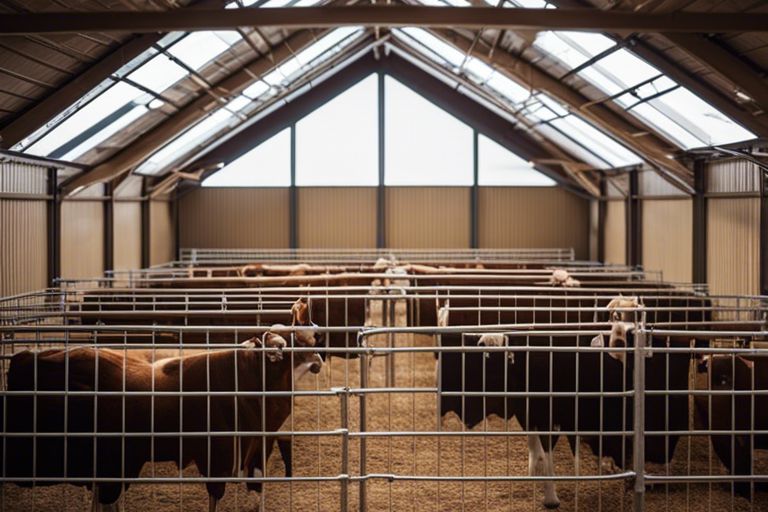It’s crucial to optimize the layout of your livestock shelter to ensure efficient use of space and provide a comfortable environment for the animals. By strategically organizing feed and water stations, creating designated resting areas, and maximizing vertical space, you can create a functional and well-organized shelter that meets the needs of your livestock. In this blog post, we will explore various tips and strategies for maximizing space in your livestock shelter layout, helping you make the most of your available area while ensuring the welfare of your animals.

Assessing Your Space Requirements
Understanding Livestock Needs
An important step in maximizing space in your livestock shelter layout is understanding the specific needs of your animals. Consider factors such as size, behavior, and comfort requirements when planning the layout of your shelter. Ensuring that your animals have enough space to move comfortably and access food and water is imperative for their health and well-being.
Calculating Space Based on Animal and Breed Type
To optimize the space in your livestock shelter, you must carefully calculate the space requirements based on the type and breed of animals you are housing. Different animals require varying amounts of space for optimal health and productivity. Consider factors such as weight, height, and social behavior when determining the space needed for each animal.
Understanding the specific space requirements for different animal breeds is crucial in maximizing space efficiency in your livestock shelter. For example, larger breeds such as cattle or horses will need more space to move around compared to smaller animals like chickens or rabbits. By calculating the space requirements based on the type and breed of animals you have, you can ensure that your shelter layout is optimized for their needs.

Designing for Efficiency and Comfort
Arrangement of Feeding and Watering Stations
For optimal efficiency in your livestock shelter layout, it is crucial to carefully plan the arrangement of feeding and watering stations. Ensure easy access for both animals and caretakers, as well as adequate space to prevent overcrowding and competition during feeding times.
Implementing Effective Waste Management Systems
On any livestock farm, waste management is a critical component of maintaining a clean and healthy environment for animals. Implementing effective waste management systems such as composting, proper drainage, and regular waste removal can help minimize odors, reduce the risk of disease, and improve overall sanitation in the shelter.
Understanding the types of waste produced by your livestock and the best practices for handling each can make a significant difference in the cleanliness and efficiency of your shelter. Regularly monitoring and adjusting your waste management systems can ensure a comfortable and safe environment for both animals and caretakers.

Innovative Space-Maximizing Solutions
Vertical Space Utilization
Innovative solutions for maximizing space in your livestock shelter layout include strategic utilization of vertical space. Implementing shelves, hanging feeders, and elevated resting areas can help you make the most of the height available in your shelter. This not only increases the usable square footage but also provides a more dynamic environment for your livestock to explore.
Flexible Shelter Designs for Changing Herd Sizes
Solutions for accommodating changing herd sizes involve implementing modular or adjustable features in your shelter design. This could include removable partitions, collapsible pens, or expandable sections that can be easily adjusted to accommodate varying numbers of animals. Having a flexible layout allows you to optimize space utilization regardless of fluctuations in your herd size, ensuring that your livestock have adequate room to move and thrive.
Designing a shelter with flexibility in mind not only maximizes space but also increases the overall functionality and efficiency of your livestock operation. By planning for potential changes in herd sizes and incorporating adaptable elements into your layout, you can create a versatile and sustainable shelter that meets your needs both now and in the future.
Maintenance and Monitoring for Continuous Improvement
Regular Assessments and Adaptation
To ensure efficient use of space in your livestock shelter, regular assessments are crucial. These assessments allow you to identify areas that may be underutilized or overcrowded, leading to necessary adaptations for improving the overall layout. By consistently monitoring and adjusting the space allocation based on the needs of your livestock, you can maximize productivity and welfare within the shelter.
Utilizing Technology for Space Management
To streamline space management in your livestock shelter, technology can be a valuable tool. Implementing software or automated systems for tracking inventory, monitoring livestock movements, and analyzing data can provide valuable insights for optimizing space utilization. The use of technology not only simplifies the monitoring process but also allows for real-time adjustments to enhance efficiency and productivity.
The integration of technology, such as sensors for monitoring feed consumption or automated gates for controlling access to different areas, can offer precision in managing space within the shelter. By harnessing the power of data and automation, farmers can make informed decisions to ensure that their livestock have adequate space and resources for optimal growth and well-being.
Adaptation is key when it comes to maximizing space in your livestock shelter layout. By staying attentive to the changing needs of your animals and leveraging technological advancements, you can continuously improve the efficiency and effectiveness of your space management strategies. Regular assessments and the utilization of technology work hand in hand to ensure that your livestock shelter layout is always optimized for the best possible outcomes.
Conclusion
Presently, maximizing space in your livestock shelter layout is crucial for ensuring the well-being and productivity of your animals. By carefully planning the layout, implementing efficient storage solutions, and utilizing vertical space, you can create a more spacious and functional environment for your livestock. Remember to consider factors such as ventilation, lighting, and ease of access when designing your shelter layout to create a comfortable and productive space for your livestock.
FAQ
Q: Why is maximizing space important in a livestock shelter layout?
A: Maximizing space in a livestock shelter layout ensures optimal living conditions for the animals, promotes efficiency in operations, and allows for better organization and management of resources.
Q: What are some key factors to consider when designing a livestock shelter layout?
A: Factors to consider include the type and number of animals, ventilation, lighting, feeding and watering systems, waste management, and ease of access for cleaning and maintenance.
Q: How can I optimize space to accommodate more animals in the shelter?
A: You can optimize space by utilizing vertical storage solutions, implementing a well-planned and efficient traffic flow, using multifunctional fixtures, and considering the animals’ movement patterns and behavior.
Q: What are some space-saving tips for organizing equipment and supplies in a livestock shelter?
A: Utilize wall-mounted storage racks, stackable containers, overhead storage shelving, and labeled bins to keep equipment and supplies organized and easily accessible while maximizing floor space.
Q: How can I create designated areas for different livestock activities within the shelter?
A: Designate specific zones for feeding, resting, milking, and waste disposal by using dividers, partitions, and color-coded markings to create separate spaces within the shelter.
Q: Are there any technological advancements that can help maximize space in a livestock shelter layout?
A: Yes, automated feeding systems, robotic milkers, GPS-guided manure scrapers, and remote monitoring devices can help optimize space utilization, improve efficiency, and enhance productivity in a livestock shelter.
Q: What are the benefits of incorporating efficient space utilization practices in a livestock shelter layout?
A: Benefits include increased animal comfort and welfare, reduced stress and injuries, improved hygiene and cleanliness, streamlined workflow, enhanced productivity, and overall cost savings in the long run.











